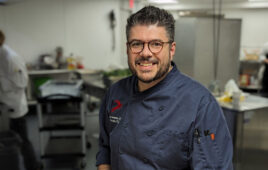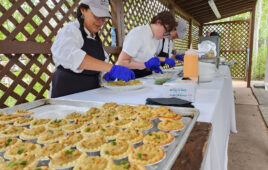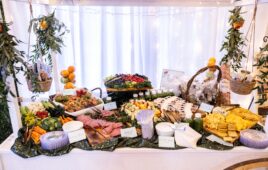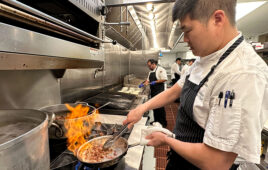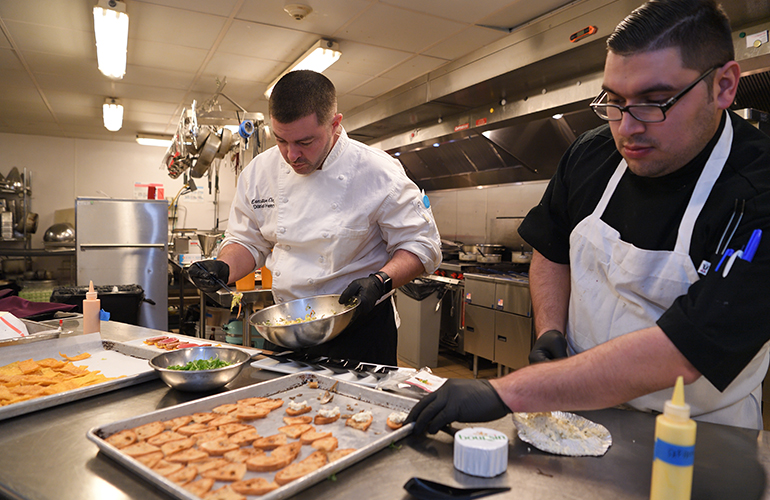
Chefs must contend with a barrage of questions these days. Plagued by rising food costs, supply chain issues, and reduced workforces, they must also determine whether it’s feasible to make foods in-house or if it’s best to outsource them. And with banquet season in full swing and not showing any signs of slowing down, thanks to the resurgence of pandemic-postponed weddings and other special occasions, they must act quickly and decisively.
From newbies in the private club sector to seasoned veterans who have handled their fair share of catered events, these chefs share their stories of managing kitchens and making critical make-or-buy decisions.
Pride of Ownership
For New Ulm (Minn.) Country Club Banquet Chef Nikki Dittrich, preparing and cooking most meals in-house is her end game.

Banquet Chef Nikki Dittrich is a one-woman operation at New Ulm CC, so she can often fulfill special requests.
“We will always do the best we can to keep producing all of our banquet food in-house,” she says. “That’s what we’re known for: fresh, homemade food.”
Having spent the past year at the club honing her craft, Dittrich draws upon her experience of preparing high-volume meals for staff and patients at nearby Mankato hospital, where she specialized in banquet-style cooking.
When planning a banquet menu, Dittrich considers two main factors: how large the group she’ll be cooking for is and how much money is required to feed them adequately. She strives to make most banquet items in the club kitchen for budget reasons.
“Our food cost is 45-50 percent lower than what I’m charging,” she notes.
Labor costs, however, do not play a part in Dittrich’s decision-making, as she is a one-woman operation in the banquet kitchen. As a result, she can often fulfill special requests or, at the very least, provide an adequate substitute. A member recently requested smoked pork chops that were not on the club’s banquet menu, so Dittrich decided to outsource from a local meat market and prepare the dish to her liking.
Space constraints, however, can sometimes impact her process.
“Depending on what the customer wants, it can get tricky figuring out how to make some things,” says Dittrich.
But she’s confident in her ability to steer members to a more readily available option that doesn’t skimp on quality.
For her budget, Dittrich finds that pork, ground beef, some seafood and pastas are her most cost-conscious options.
“Chicken used to be our top seller, but since the bird flu, it has been tough getting that in,” she says.
With prices in constant flux, she admits to keeping a closer eye on all her banquet goods and products.
Dittrich is inspired by the fact that she has free reign over her kitchen. And while inflation will undoubtedly impact what she decides to outsource for the coming season, she’s not deterred by these concerns.
“Since I started here, I have brought so many new, fun, and flavorful dishes to our menu,” Dittrich says.
Her more noteworthy selections include a triple-threat surf (a crab-stuffed lobster tail topped and closed with grilled shrimp, mushroom risotto and a lemon beurre blanc sauce); a rosemary-infused filet mignon with a parmesan garlic couscous and asparagus; and smoked lobster mac and cheese.
“I love when the members give me a challenge with a dish, and I execute it,” Dittrich says. “It’s a gratifying feeling.”
A Shore Thing
At Eastern Shore Yacht & Country Club in Melfa, Va., Executive Chef Kayleigh Johnson arrived at just the right time. Two years ago, following a complete rebuild of the club, she entered the private club circuit fresh out of a culinary arts teaching gig where she had the opportunity to put her mark on banquet production.

Kayleigh Johnson, Executive Chef
of Eastern Shore Yacht & CC, says members understand that local or house-made items often come at a premium.
Undaunted by a modest-sized staff of four responsible for 200-guest events regularly, Johnson has developed a keen understanding of what works—and what doesn’t—for club affairs.
“What food we outsource often comes down to how much labor would be invested and whether or not that labor investment is logistically worthwhile,” she explains. Dough work, for example, is not feasible in her kitchen. “While we have the technical ability to complete it, it wouldn’t make sense to have a tabletop mixer produce 300 rolls per weekend when we need to focus our efforts beyond just banquets at any given moment,” she explains.
Johnson estimates the club outsources between 15 and 20 percent of its banquet products.
Among the factors impacting her decision are limited kitchen accommodations and equipment usage. The club’s specialized combi oven can only hold 10 half-sheet-sized pans simultaneously, with a three-inch maximum between pans.
“This requires us to rent ovens, smokers, or rotisseries to accommodate larger groups with larger menus, which ultimately affects the cost of each banquet,” she says, adding that the club is currently evaluating more cost-efficient equipment alternatives that would better streamline production.
Her four-person crew also impacts which items are made vs. bought. “I cannot have a staff member cleaning and slicing mushrooms for an hour when I can outsource sliced mushrooms for $4 more,” she notes.
In addition to dough-based products like puff pastry, tart bases and phyllo cups, Johnson purchases simple sauces, such as steak sauce, tartar and cocktail sauce. And while hot honey has become a popular condiment this year, she is honoring members’ brand requests rather than infusing her own. This, of course, sometimes comes at a cost.
“While customers prefer that their fish be local, their microgreens sourced on The Shore and produce to be grown as close to home as possible, they also understand that it does come at a slightly higher premium,” she says.
Despite the cost, those who book banquets at Eastern Shore can expect a well-balanced lineup of local classics mixed with innovations. This season’s menu includes tried-and-true smoked oyster canapes, crab-stuffed flounder, and new selections like bruschetta chicken, BBQ salmon, and maple-roasted pork tenderloin.
Making Hard Choices
Deciding what foods should be made in-house is a choice that Daniel Henry does not take lightly. The Executive Chef of Manchester Country Club in Bedford, N.H., who has spent the bulk of his career at country clubs and high-end restaurants in metro New York, ventured up to New England a year ago, determined to do right by his members.
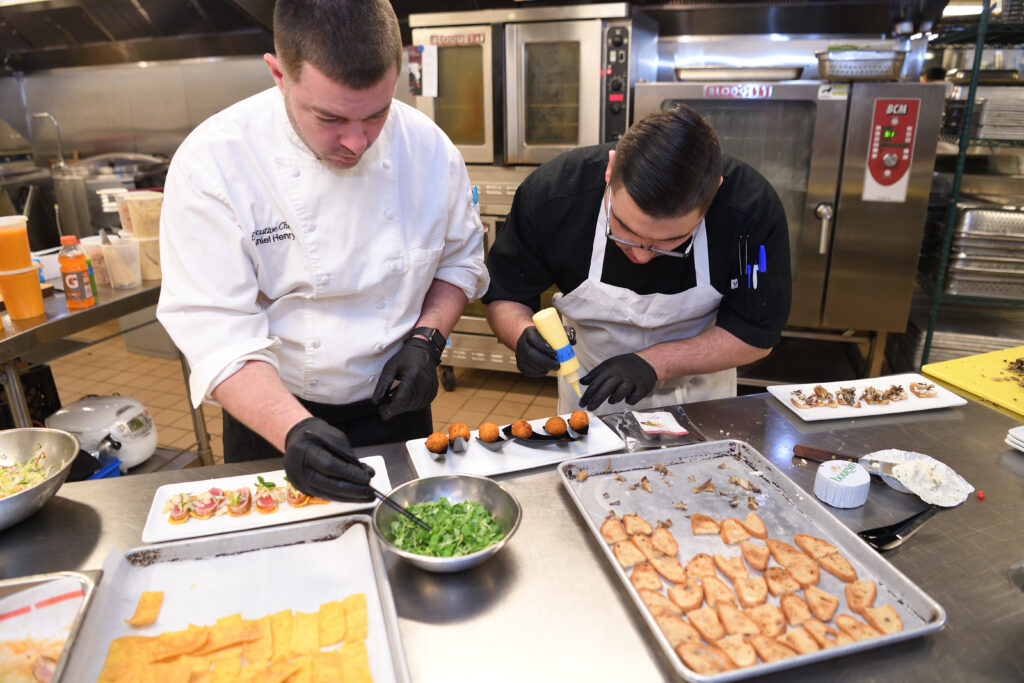
At Manchester CC, Executive Chef Daniel Henry (left) and his team prepare 75% of banquet products from scratch.
But in the wake of the pandemic, Henry, like most chefs, has had to contend with rising costs for goods and labor, not to mention a vast reduction in culinary staffing.
“Pay rates have gone up 25 percent in the past year, but it’s still hard to find workers,” he says.
Balancing his banquet operations with a la carte dining service has proven challenging, especially because 75 percent of his product is scratch-made.
To help make the best purchases for his kitchen, Henry says he relies on the club’s event-planning software for organizing and figuring out what to buy.
“It also allows me to forecast—to see what I can stock up on or buy something now so I can save it for later,” he adds. This comes in handy for guacamole production, with his kitchen using anywhere from 90-130 cases of avocados per week. Purchasing premade guac in bulk and then seasoning it himself has been a tremendous time- and money-saver.
Salsa is another staple he considers outsourcing. “It’s nice to have fresh pico, but we will buy chopped tomatoes instead,” he adds.
When assessing what can be cooked in his kitchen, Henry must also ensure a quality product—and sometimes that means preceding a more straightforward process. He points to bacon-wrapped scallops, a New England appetizer favorite, as something he previously outsourced but has since resumed making. He also prepares his vegetables but opts to purchase precut and peeled potatoes. And while Henry prides himself on making his stocks, he outsources sauces and demi-glace bases.
“We go through so much of this; it’s impossible to keep up,” he adds. “We can add red wine, doctor it up a bit, and it saves us time.”
Henry’s advice when deciding what to buy? Work with the right outside partners.
“Find vendors that don’t do everything—companies that specialize in a good product,” he says.
For Henry, that means working with various companies specializing in certain products.
“Members pay a lot of money for these special occasions,” he notes. “The quality must be there.”

